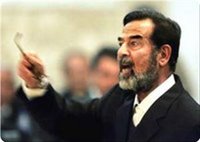
Timing and Hostile Repartee Creates Further Division
By NIR ROSEN
"Saddam Hussein became the first modern Arab dictator to die violently since Egypt's Anwar Sadat in 1981. Saddam's hanging at the hands of chubby Iraqi men wearing ski masks is likely to be perceived by many as an American execution and as part of a trend of American missteps contributing to sectarian tensions in Iraq and the region. The trial of Saddam was viewed by detractors as an event stage-managed by the Americans. According to Human Rights Watch, the Iraqi judges and lawyers involved in prosecuting Saddam were ill prepared and relied on their American advisers. American minders shut off the microphones and ordered the translators to halt whenever they disapproved of what was being said by the defendants.
The important Muslim holiday of Eid al Adha was due to begin over the weekend. For Sunnis it began on Saturday the 30th of December. For Shias it begins on Sunday the 31st. According to tradition in Mecca, battles are suspended during the Hajj period so that pilgrims can safely march to Mecca. This practice even predated Islam and Muslims preserved this tradition, calling this period 'Al Ashur al Hurm,' or the months of truce. By hanging Saddam on the Sunni Eid the Americans and the Iraqi government were in effect saying that only the Shia Eid had legitimacy. Sunnis were irate that Shia traditions were given primacy (as they are more and more in Iraq these days) and that Shias disrespected the tradition and killed Saddam on this day. Because the Iraqi constitution itself prohibits executions from being carried out on Eid, the Iraqi government had to officially declare that Eid did not begin until Sunday the 31st. It was a striking decision, virtually declaring that Iraq is now a Shia state. Eid al Adha is the festival of the sacrifice of the sheep. Some may perceive it as the day Saddam was sacrificed.
Saddam had been in American custody and was handed over to Iraqis just before his execution. It is therefore hard to dismiss the perception that the Americans could have waited, because in the end it is they who have the final say over such events in Iraq. Iraqi officials have consistently publicly complained that they have no authority and the Americans control the Iraqi police and the Army. It is therefore unusual that Iraqis would suddenly regain sovereignty for this important event. For many Sunnis and Arabs in the region, this appears to be one president ordering the death of another president. It was possibly a message to Sunnis, a warning. The Americans often equated Saddam with the Sunni resistance to the occupation. By killing Saddam they were killing what they believed was the symbol of the Sunni resistance, expecting them to realize their cause was hopeless. Sunnis could perceive the execution, and its timing, as a message to them: "We are killing you." But Saddam's death might now liberate the Sunni resistance from association with Saddam and the Baathists. They can now more plausibly claim that they are fighting for national liberation and not out of support for the former regime as their American and Iraqi government opponents have so often claimed. A lack of a hood (victims normally do not have a choice to wear a hood) a scarf to prevent rope burn for the soon to be distributed photo, a hallmark of US "We Got Him" psyops tactics. Even the US plane that flew him to his final resting spot seems to indicate US management.......
.....One thing that is clear, is that the death of Saddam did not bring closure or peace to Iraq. Sunnis are now gathering at Saddam's grave, demonstrators are now showing his iconic image and revenge has been threatened. President George Bush declared his nemesis' death "a milestone" and it may just be the clearest message that is there will be no mercy for Sunnis in a Shia and Kurdish dominated Iraq."

No comments:
Post a Comment